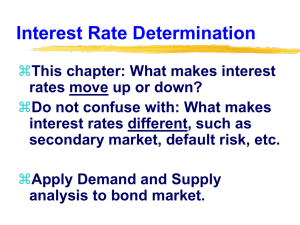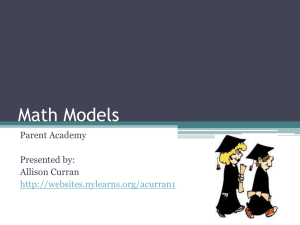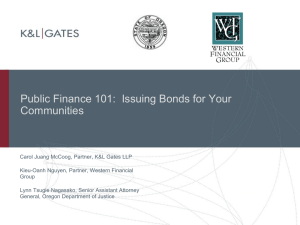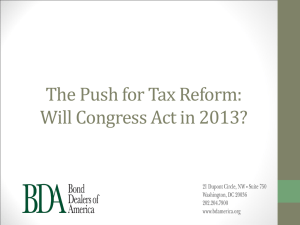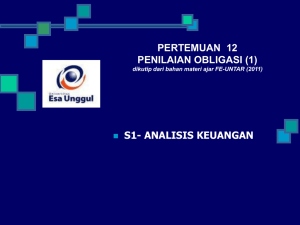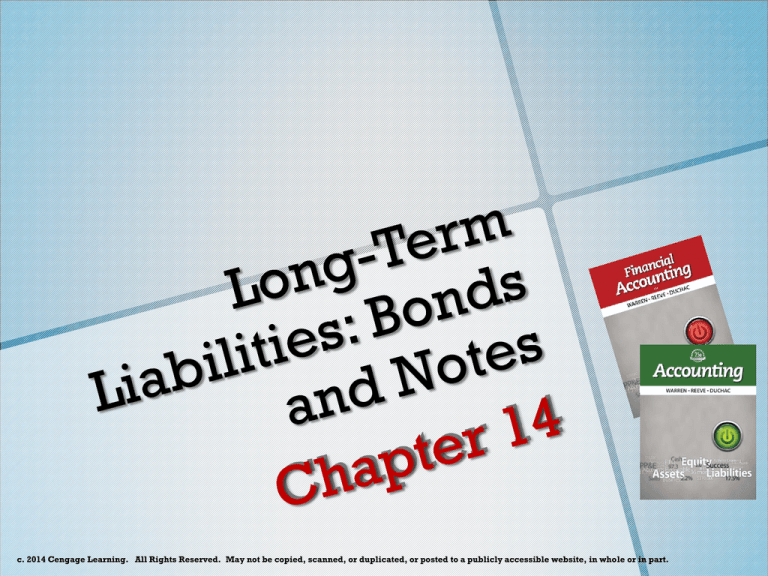
c. 2014 Cengage Learning. All Rights Reserved. May not be copied, scanned, or duplicated, or posted to a publicly accessible website, in whole or in part.
Learning Objectives
1.
2.
3.
4.
5.
6.
Compute the potential impact of long-term borrowing
on earnings per share.
Describe the characteristics and terminology of
bonds payable.
Journalize entries for bonds payable.
Describe and illustrate the accounting for installment
notes.
Describe and illustrate the reporting of long-term
liabilities including bonds and notes payable.
Describe and illustrate how the number of times
interest charges are earned is used to evaluate a
company’s financial condition.
c. 2014 Cengage Learning. All Rights Reserved. May not be copied, scanned, or duplicated, or posted to a publicly accessible website, in whole or in part.
Financing Corporations
o Corporations finance their operations using
the following sources:
Short-term debt, such as purchasing goods or
services on account.
Long-term debt, such as issuing bonds or notes
payable.
Equity, such as issuing common or preferred stock.
Financing Corporations
o A bond is a form of an interest-bearing note.
Like a note, a bond requires periodic interest
payments, and the face amount must be repaid
at the maturity date.
Financing Corporations
Huckadee Corporation is considering the
following plans to issue debt and equity:
Financing Corporations
o In deciding among financing plans, the effect
on earnings per share is often considered.
o Earnings per share (EPS) measures the income
earned by each share of common stock. It is
computed as follows:
Net Income - Preferred Dividends
Earnings per Share =
Number of Common Shares Outstanding
Financing Corporations
o Assume the following data for Huckadee
Corporation:
Earnings before interest and income taxes are
$800,000.
The tax rate is 40%.
All bonds or stocks are issued at their par or face
amount.
The effect of the preceding financing
plans is shown in Exhibit 1 (next slide).
FINANCING
CORPORATIONS
Highest EPS
FINANCING
CORPORATIONS
Highest EPS
c. 2014 Cengage Learning. All Rights Reserved. May not be copied, scanned, or duplicated, or posted to a publicly accessible website, in whole or in part.
Bond Characteristics and Terminology
o The underlying contract between the company
issuing bonds and the bondholders is called a
bond indenture.
Bond Characteristics and Terminology
o Usually, the face amount of each bond, called
the principal, is $1,000, or a multiple of $1,000.
Interest on bonds may be payable annually,
semiannually, or quarterly. Most pay interest
semiannually.
Bond Characteristics and Terminology
o When all bonds of an issue mature at the same
time, they are called term bonds.
o If they mature over several dates, they are
called serial bonds.
o Bonds that may be exchanged for other
securities are called convertible bonds.
Bond Characteristics and Terminology
o Bonds that a corporation reserves the right to
redeem before their maturity are called
callable bonds.
o Bonds issued on the basis of the general credit
of the corporation are called debenture bonds.
Proceeds from Issuing Bonds
o When a corporation issues bonds, the
proceeds received for the bonds depend on:
The face amount of the bonds, which is the amount
due at the maturity date.
The interest rate on the bonds.
The market rate of interest for similar bonds.
Proceeds from Issuing Bonds
o The face amount and the interest rate on the
bonds are identified in the bond indenture.
o The interest rate to be paid on the face amount
of the bond is called the contract rate or
coupon rate.
Proceeds from Issuing Bonds
o The market rate of interest, or effective rate of
interest, is determined by transactions
between buyers and sellers of similar bonds.
o The market rate of interest is affected by a
variety of factors, including investors’
expectations of current and future economic
conditions.
PROCEEDS FROM
ISSUING BONDS
PROCEEDS FROM
ISSUING BONDS
PROCEEDS FROM
ISSUING BONDS
Proceeds from Issuing Bonds
o Summary
If the market rate equals the contract rate, bonds
will sell at the face amount.
If the selling price of the bonds is less than the face
amount, the bonds are selling at a discount.
If the selling price of the bonds is more than the
face amount, the bonds are selling at a premium.
Proceeds from Issuing Bonds
o The price of a bond is quoted as a percentage
of the bond’s face value.
A $1,000 bond quoted at 98 could be purchased or
sold for $980 ($1,000 x 0.98).
A $1,000 bond quoted at 109 could be purchased or
sold for $1,090 ($1,000 x 1.09).
c. 2014 Cengage Learning. All Rights Reserved. May not be copied, scanned, or duplicated, or posted to a publicly accessible website, in whole or in part.
Bonds Issued at Face Amount
o On January 1, 2013, Eastern Montana
Communications Inc. issued the following
bonds:
Bonds Issued at Face Amount
o Since the contract rate of interest and the
market rate of interest are the same, the bonds
will sell at their face amount.
Bonds Issued at Face Amount
o Every six months (on June 30 and December
31) after the bonds are issued, interest of
$6,000 ($100,000 × 0.12 × 6/12) is paid.
Bonds Issued at Face Amount
o The bond matures on December 31, 2017. At
this time, the corporation pays the face amount
to the bondholders.
Bonds Issued at a Discount
o On January 1, 2013, Western Wyoming
Distribution Inc. issued $100,000, 12%, fiveyear bonds when the market rate was 13%.
(Interest will be paid semiannually on June 30
and December 31.)
Reminder:
Bonds Issued at a Discount
The firm issued the $100,000 bonds for $96,406
(a discount of $3,594).
The discount may be viewed as
the amount required by investors
to accept a bond rate of interest
below the market rate.
Amortizing a Bond Discount
o The two methods of computing the
amortization of a bond discount are:
Straight-line method
Effective interest rate method, sometimes called
the interest method
o
Both methods amortize the same total amount
of discount over the life of the bonds.
Amortizing a Bond Discount
o The effective interest rate method is required
by generally accepted accounting principles.
o However, the straight-line method may be used
if the results do not differ significantly from the
interest method.
Amortizing a Bond Discount
o On June 30, 2013, Western Wyoming
Distribution Inc. pays six-months’ interest on
the five-year bond issued earlier, and the bond
discount is amortized ($3,594 × 1/10). The
interest payment and amortization entries can
be combined as follows:
*$100,000 ×
12% × 6/12
Bonds Issued at a Premium
o On January 1, 2013, Northern Idaho
Transportation Inc. issued $100,000, 12%, fiveyear bonds for $103,769. The market rate of
interest is 11%.
Reminder:
Amortizing a Bond Premium
o The entry to record the first interest payment
and the amortization of the premium on the
$100,000, 12%, five-year bonds issued on
January 1, 2013, is made on June 30, 2013. The
combined entry is as follows:
Bond Redemption
o A corporation may call, or redeem, bonds
before they mature. Callable bonds can be
redeemed by the issuing corporation within
the period of time and at the price stated in the
bond indenture. Normally, the call price is
above the face value.
Bond Redemption
o The carrying amount of bonds payable is the
face amount of the bonds less any unamortized
discount or plus any unamortized premium.
Bond Redemption
o A gain or loss may be realized on a bond
redemption as follows:
A gain is recorded if the price paid for the
redemption is below the bond carrying amount.
A loss is recorded if the price paid for the
redemption is above the carrying amount.
Bond Redemption
o
On June 30, 2013, a corporation has a bond issue of
$100,000 outstanding, on which there is an
unamortized premium of $4,000. The corporation
redeems one-fourth of the bonds for $24,000.
Gains on the redemption of bonds are reported in
the Other Income section of the income statement.
Bond Redemption
o The corporation calls the remaining $75,000 of
outstanding bonds, which are held by a private
investor, for $79,500 on July 1, 2013.
Losses on the redemption of bonds are reported
in the Other Loss section of the income statement.
c. 2014 Cengage Learning. All Rights Reserved. May not be copied, scanned, or duplicated, or posted to a publicly accessible website, in whole or in part.
Installment Notes
o An installment note is a debt that requires the
borrower to make equal periodic payments to
the lender for the term of the note. Unlike
bonds, a note payment includes the following:
Payment of a portion of the amount initially
borrowed, called the principal
Payment of interest on the outstanding balance
Installment Notes
o Installment notes are often used to purchase
specific assets, such as equipment, and are
often secured by the purchased asset.
o When a note is secured by an asset, it is called
a mortgage note.
o If the borrower fails to pay a mortgage note,
the lender has the right to take possession of
the pledged asset.
Issuing an Installment Note
o Lewis Company issues a $24,000, 6%, five-year
note to City National Bank on January 1, 2013.
The annual payment is $5,698.
ANNUAL PAYMENTS
$24,000 x 0.06
ANNUAL PAYMENTS
$5,698 – $1,440
ANNUAL PAYMENTS
$24,000 – $4,258
Annual Payments
o The entry to record the first payment on
December 31, 2013, is as follows:
Annual Payments
o The entry to record the second payment on
December 31, 2014, is as follows:
Annual Payments
o The entry to record the final payment on
December 31, 2017, is as follows:
o After the entry is posted, the balance in Notes
Payable related to this note is zero.
c. 2014 Cengage Learning. All Rights Reserved. May not be copied, scanned, or duplicated, or posted to a publicly accessible website, in whole or in part.
REPORTING LONGTERM LIABILITIES
c. 2014 Cengage Learning. All Rights Reserved. May not be copied, scanned, or duplicated, or posted to a publicly accessible website, in whole or in part.
Number of Times Interest Charges are Earned
o Analysts assess the risk that bondholders will
not receive their interest payments by
computing the number of times interest
charges are earned during the year as follows:
Number of
Times Interest
Charges are =
Earned
Income Before Income Tax +
Interest Expense
Interest Expense
c. 2014 Cengage Learning. All Rights Reserved. May not be copied, scanned, or duplicated, or posted to a publicly accessible website, in whole or in part.
Present Value Concept/Pricing Bonds Payable
o When a corporation issues bonds, the price
that investors are willing to pay for the bonds
depends on the following:
The face amount of the bonds, which is the amount
due at the maturity date.
The periodic interest to be paid on the bonds.
The market rate of interest.
Present Value Concept
o The time value of money concept recognizes
that an amount of cash received today is worth
more than the same amount of cash to be
received in the future.
o Present value is the current worth of a future
sum of money or stream of cash flows given a
specified rate of return.
o The amount to be received in the future if you
make a deposit now is the future value.
Present Value of an Amount
o A $1,000, 10% bond is purchased. It pays
interest annually and will mature in one year.
Present value of $1,000
to be received one year
from today
Today
$1,000
10%
payable
annually
One Year
from
TODAY
PRESENT VALUE OF
AN AMOUNT
Present Value of an Amount
$1,000 X .90909 = $909.09
Present value of $1,000
to be received one year
from today
$1,000
10%
payable
annually
Today
$909.09
One Year
from TODAY
Present Value of an Amount
o A $1,000, 10% bond is purchased. It pays
interest annually and will mature in two years.
Present value of $1,000
to be received two
years from today
Today
$1,000
10%
payable
annually
End of
Year 1
End of
Year 2
PRESENT VALUE OF
AN AMOUNT
Present Value of an Amount
$1,000 X .82645 = $826.45
Present value of $1,000
to be received two
years from today
Today
$826.45
$1,000
10%
payable
annually
End of
Year 1
End of
Year 2
Present Value of the Periodic Receipts
o A series of equal cash receipts spaced equally
in time is called an annuity.
o The present value of an annuity is the sum of
the present values of each cash receipt.
Present Value of the Periodic Receipts
o Assume that $100 is to be received annually for
two years and that the market rate of interest is
10%.
o The next slide illustrates that the present value
of the amount ($100) at 10% for one year and
the present value of the amount ($100) at 10%
for two years is summed to arrive at the
present value of the annuity.
Present Value of the Periodic Receipts
$100
$100
Interest
payment
Today
$90.91
$82.64
$173.55
Interest
payment
End of
Year 1
$100 × 0.90909
$100 × 0.82645
Present value, at 10%, of $100
interest payments to be received
each year for 2 years (rounded)
End of
Year 2
Present Value of the Periodic Receipts
o When the present value of an annuity (a series
of equal cash receipts at fixed intervals) is
involved, the present value of an annuity of $1
at compound interest (Exhibit 5) can be used.
PRESENT VALUE OF
THE PERIODIC
RECEIPTS
$100 x 1.73554 = $173.55
The same
amount as
derived
earlier
Pricing Bonds
o Southern Utah Communications Inc. issued
$100,000, 12%, five-year bonds on January 1,
2013. The bonds pay interest semiannually on
June 30 and December 31.
Market Rate of Interest at 12%
o Present value of face amount of $100,000 due
in 5 years = $ ?
6% used because the bonds are semiannual
Market Rate of Interest at 12%
o Present value of face amount of $100,000 due
in 5 years = $ ?
10 semiannual periods in 5 years
Market Rate of Interest at 12%
o Present value of face amount of $100,000 due
in 5 years ($100,000 × 0.55840) =
$55,840.
o This amount gives us one part of the total
present value of the bonds.
Market Rate of Interest at 12%
o Next, we need to determine the present value
of 10 semiannual interest payments of $6,000 at
12% compounded semiannually.
Market Rate of Interest at 12%
o Present value of 10 semiannual interest
payments of $6,000 at 12% compounded
semiannually ($6,000 x 7.36009) = $ 44,160
Market Rate of Interest at 12%
Present value of face amount of
$100,000 due in 5 years
($100,000 × 0.55840) =
Present value of 10 semiannual
interest payments of $6,000
at 12% compounded semiannually
($6,000 × 7.36009) =
Total present value of bonds
When the face interest rate is the
same as the market rate of interest,
the total present value of the bonds
will equal the total face value.
$ 55,840
44,160
$100,000
Market Rate of Interest at 11%
o Present value of face amount of $100,000 due
in 5 years ($100,000 × 0.58543) = $58,543.
Market Rate of Interest at 11%
Present value of face amount
of $100,000 due in 5 years
($100,000 × 0.58543) =
Present value of 10 semiannual
interest payments of $6,000 at
11% compounded semiannually
($6,000 × 7.53763) =
$ 58,543
45,226
Market Rate of Interest at 11%
Present value of face amount
of $100,000 due in 5 years
($100,000 × 0.58543) =
$ 58,543
Present value of 10 semiannual
interest payments of $6,000 at
11% compounded semiannually
($6,000 × 7.53763) =
Total present value of bonds
45,226
$103,769
c. 2014 Cengage Learning. All Rights Reserved. May not be copied, scanned, or duplicated, or posted to a publicly accessible website, in whole or in part.
Effective Interest Rate Method
o The effective interest rate method of
amortization, sometimes called the interest
method, provides for a constant rate of interest
over the life of the bonds.
AMORTIZATION OF
DISCOUNT
Amortization of Discount
o The entry to record the first interest payment
on June 30, 2013, and the related discount
amortization is as follows:
AMORTIZATION OF
PREMIUM
Amortization of Premium
o The entry to record the first interest payment
on June 30, 2013, and the related premium
amortization is as follows:
c. 2014 Cengage Learning. All Rights Reserved. May not be copied, scanned, or duplicated, or posted to a publicly accessible website, in whole or in part.




